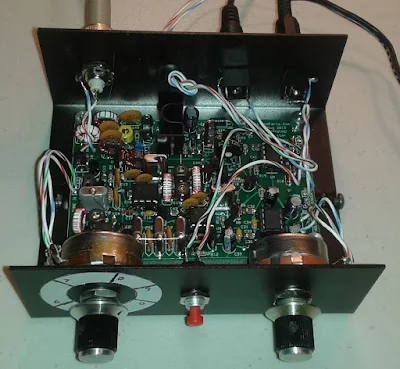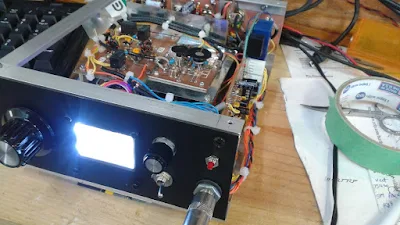Rupert with some sort of SDR rig
I was delighted when Rupert posted some sage advice about how to deal with my recalcitrant amplifier. He managed to include a reference to Mr. Spock in his message, helpfully noting that some of these amp problems would challenge the Vulcan's logical powers. That made me feel better. I sent a few words of thanks to Rupert and got back this really great "Knack Story":
Hi Bill,
Well, all I have on HF amp instability is anecdote and half-remembered theory. But I do like the sort of challenges that building RF on the bench brings up - a problem worthy of one's attention proves its worth by fighting back!
I've enjoyed Soldersmoke (or should I say Soddersmoke) for years now, and even if I haven't bought the T-shirt, have bought your book. I first inhaled the demon fumes when I was barely into double digits, and the addiction kicked in hard - I fixed my first radio, a valve (tube!) FM 1950s broadcast receiver using a soldering iron that was actually one of my father's wooden-handled screwdrivers heated on the gas ring of the cooker in the kitchen. My parents were mystified but supportive...
London is indeed a hard place to play radio. But that makes it doubly pleasurable when it works: it rather feels like you're operating under cover, a special forces op sneaking the signal out under the noses of the regime. I once had a birthday picnic on Hampstead Heath where I brought my SOTA beam and fishing-pole mast: the local constabulary turned up and were also mystified but not quite so supportive... "What if everyone did it?" they asked. "Oh, if only..." I thought but did not say.
I do hope you can pacify your errant amp. Sometimes these things can be fixed by brainpower, sometimes by just mucking around until they get bored before you do. But normally I find that I've learned a lot when the problem's solved. RF isn't black magic, it's a gateway into another world that's marvellous and enthralling, but ours to know. I read a really good paper by Freeman Dyson, where he said that Maxwell invented modern physics, because his equations were the first to show that the real world of how things work is both beyond our natural experience, but accessible through thought and logic. The real entrancing thing about radio is that it proves this - we can talk across the world by translating our knowledge into a tiny handful of otherwise inert bits and pieces that tap into something utterly beyond our senses. And it's open to anyone who cares enough to try.
How cool is that? (I had to go and find that Dyson paper again - here it is, if you're interested: http://www.damtp.cam.ac.uk/
(I also have an unshakeable and unhelpful addiction for obscure but interesting radios, as my QRZ page confesses. And things I helped design and build when I was an engineer are now in the NSA and Bletchley Park cryptologic museum collections. That, as they say, is quite another story...)
Anyway, thanks again for emailing - I'm thrilled to hear from you, and perhaps, who knows, one day we may make contact the way God and Maxwell intended - via QRP on a lively band while dodging the noise and bouncing our photons off the Heaviside Layers.
Best 73s,
Rupert, G6HVY
------------------------
Rupert's QRZ.com page contains additional evidence of his Knack affliction and International Brotherhood of Electronic Wizards membership:
Other equipment here includes a Wireless Sets No 19 Mk III, an R1155, a Barlow Wadley XCR-30, an ICR-73, some PMR stuff on 4 metres, some old CB kit (shhhh!) and other obscurities. I like kit that has something different about it the 19 set, for example, is of course famous for its wartime role, but it was also the very first transceiver. The XCR-30 is really interesting, not only for being a high tech product of 60s apartheid South Africa (so a morally complex thing to own), but for having a very esoteric design that provides 0-31MHz coverage without bandswitching, very high stability and accuracy (you can generally pre-tune an AM broadcast station anywhere on the bands from the dial and be within 1KHz on switch-on, and all from a handful of transistors. There are stories to tell about all of my radios.
Started in radio when I was too young to get my ticket, so was forced - forced, I tell you - onto CB radio, in the days when it was very popular and very illegal. Had a couple of crystal-TX, super-regen RX walkie-talkies (QRPp and RX so wide I could pick up Radio South Africa on the BC 11m band) to start with, thence bought a 'for conversion to 10m' populated CB PCB from a batch at Plymouth ARC Rally and just bunged a set of toggle switches on the PLL-02 divider inputs. This was the mid-late70s, when skip was high... Did the RAE ASAP after my 16th birthday, first legal amateur rig (I may have built things with 6V6s that may have made odd noises on the local Top Band AM Sunday morning net) was an Icom IC-2E. My richer friend, who was a G6E, had an FT-290R, which was obv. nicer but obv. deafer. "FT-290. IC-2E. I can hear him. He can't hear me." Used 19 sets at school, so have that addiction too. Since then, the hobby has been in and out of my life (like QTHs, wives, jobs and money), but the love of radio never has.
---------------------------
I also understand that he once worked at a dodgy TV repair shop in the back streets of Plymouth and can still swap out a gassy PL509 with the best of 'em.
Our book: "SolderSmoke -- Global Adventures in Wireless Electronics" http://soldersmoke.com/book.htm Our coffee mugs, T-Shirts, bumper stickers: http://www.cafepress.com/SolderSmoke Our Book Store: http://astore.amazon.com/contracross-20


































































